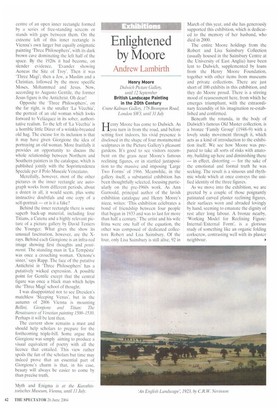Enlightened by Moore
Andrew Lambirth
Henry Moore Dulwich Picture Gallery, until 12 September British Landscape Painting in the 20th Century Crane Kalman Galloy, 178 Brompton Road, London SW3, until 31 July
Her"Moore has come to Dulwich. As you turn in from the road, and before setting foot indoors, his vivid presence is disclosed in the shape of four monumental sculptures in the Picture Gallery's pleasant gardens. It's good to see visitors recumbent on the grass near Moore's famous reclining figures, or in startled juxtaposition to the massive and imposing 'Large Two Forms' of 1966. Meanwhile, in the gallery itself, a substantial exhibition has been thoughtfully selected, focusing particularly on the pre-1960s work. As Ann Garrould, principal author of the lavish exhibition catalogue and Henry Moore's niece, writes: This exhibition celebrates a bond of friendship between four people that began in 1933 and was to last for more than half a century.' The artist and his wife Irina were one half of the equation, the other was composed of dedicated collectors Robert and Lisa Sainsbury. Of the four, only Lisa Sainsbury is still alive, 92 in
March of this year, and she has generously supported this exhibition, which is dedicated to the memory of her husband, who died in 2000.
The entire Moore holdings from the Robert and Lisa Sainsbury Collection (usually housed in the Sainsbury Centre at the University of East Anglia) have been lent to Dulwich, supplemented by loans from the Henry Moore Foundation, together with other items from museums and private collections. There are just short of 100 exhibits in this exhibition, and they do Moore proud. There is a stirring mood of reassessment here, from which he emerges triumphant, with the extraordinary fecundity of his imagination re-established and confirmed.
Beneath the rotunda, in the body of Dulwich's famous Old Master collection, is a bronze 'Family Group' (1948-9) with a lovely snaky movement through it, which acts as a kind of introduction to the exhibition itself. We see how Moore was prepared to take all sorts of risks with anatomy, building up here and diminishing there — in effect, distorting — for the sake of the emotional and formal truth he was seeking. The result is a sinuous and rhythmic whole which at once conveys the unified identity of the three figures.
As we move into the exhibition, we are greeted by a couple of those poignantly patinated carved plaster reclining figures, their surfaces worn and abraded lovingly by hand, seeming to emanate the dignity of rest after long labour. A bronze nearby, 'Working Model for Reclining Figure: Internal/External Form', is a glorious study of something like an organic folding corkscrew, contrasting well with its plaster neighbour. There are some unusual things on show: a carved relief head in slate and a stone serpent's head, like a mediaeval gutterspout, both from a private collection in Switzerland. The range of materials is wide, from bronze and cast concrete to Burgundy stone, lead, African wonderstone and the superhard lignum vitae from which 'Bird Basket', one of the artist's own favourites, is carved. The forms which Moore is able to draw out of stone or wood are apparently simple, as in primitive art, but are in truth sophisticated and densely expressive. 'Square Form' and 'Carving', both from 1936, and some of the most abstract images here are like Ben Nicholson paintings in three-dimensions, and are immensely tactile. It's good to see so many sculptures at close quarters and not languishing behind glass, though the temptation to stroke them is severe.
Look, for instance, at the Green Hornton stone mother and child, left shoulder worthy of a rugby player, surrounding and protecting her child; or the tiny stringed-lead version of the same theme. A tremendous group of seated female figures, mostly in concrete, complements the powerful family groups and the room of war drawings. The show has been beautifully installed and presented. Those who are casual enough to suggest that we have had too many Henry Moore exhibitions should be blindfolded and led to Dulwich's gentle pleasance for much-needed enlightenment.
Landscape was a great influence on Moore's work (just think of the similarity in profile between one of his reclining figures and a mountain range), and he was always meticulous about how his work was sited outdoors. Appropriately, among a store of treats in Crane Kalman's sumptuous survey of British 20th-century landscape art, is to be found a rather touching late Moore drawing of three trees.
The exhibition is a thoughtful tribute to the gallery's founder, Andras Kalman, who celebrated his 85th birthday last month, and features many of the artists, such as Winifred Nicholson, Lowry and Mary Newcomb, that the gallery has made a name for itself by showing. A couple of early Victor Pasmore oils, both from around 1940, remind us what a sensitive landscape painter he was before going abstract. There's a really beautiful, if sketchy, early Ben Nicholson of Bank's Head, and an evocative snow-scene by John Nash. Graham Sutherland gets persuasively mountainous while Lowry meditates on the loneliness of the open road in 1 his magnificent 'Derbyshire Landscape'. There are fine things by Stanley Spencer and Paul Nash, while The Hop Garden' by Alan Reynolds is a model of elegiac restraint. Matthew Smith is represented by the glowing 'Cornish Garden with Monkey Puzzle Tree' (a painting which would have enhanced Tate Britain's current Art of the Garden show), but perhaps the quintessential image is the rookhaunted verdant plain in C. R. W. Nevinson's 'An English Landscape'. Here's a vision of understated loveliness to dream on.



































































 Previous page
Previous page